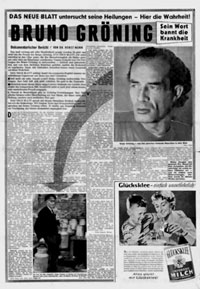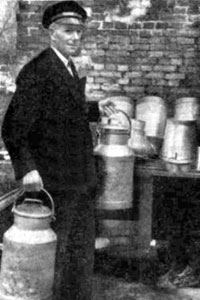"Bruno Gröning - His Word Bans Illness"
Documentary report "Das Neue Blatt" magazine, May 9, 1957

Report by Dr. Horst Mann
It must be made perfectly clear from the start: this has nothing to do with the person Bruno Gröning. The magazine Das Neue Blatt does not want to join the chorus of those who effusively praise him as a healer or accuse him of being a charlatan. Our task was to investigate Bruno Gröning’s healings critically and incorruptibly, guided by the honest attempt to finally find the truth - because all suffering people are entitled to this truth.
Das Neue Blatt thus opens an exciting chapter in our time. These are the facts:
- For more than ten years, Bruno Gröning has achieved verifiable healings. The number can’t be estimated. It runs into the thousands.
- This man appeared in court several times because of his method. They had to acquit him. He is now confidently awaiting a new and very controversial court case.
- There are Gröning associations all over Germany. Their members view this man - who gave them not only healing, but also spiritual support - with complete respect.
Das Neue Blatt talked with these people. We critically investigated the healing successes. We questioned physicians and scientists, and we spoke with Bruno Gröning himself. He voluntarily made material available to us that had not previously been available to anybody.
The following took place on November 27, 1953, in the small village of Ostenfeld, 14 kilometers east of Husum. An oppressive tension was in the room at the village inn. Like an iron clamp, s it gripped the hearts of the people sitting closely packed on benches and rows of chairs. There may have been a hundred, perhaps a hundred and fifty.
They had come from Ostenfeld and from the neighboring villages between Rendsburg, Schleswig, Husum and Kappeln. Word spread quickly: Bruno Gröning has arrived! He is said to have once again healed sick people. Perhaps he could help me too, or the father with gout, or the child who was so frail and at whom the doctor only shrugged his shoulders. These might have been the thoughts of the people who had assembled here tonight.
The dim light had trouble permeating the room. It showed faces full of expectation and belief. But it also reflected the eyes of skeptical and curious people. They did not expect anything special. They only wanted to be present so they could take part in conversation in those long winter evenings of the year 1954. Nothing much was happening here in these villages. The conversations were always about the same topics: weather, harvest, cattle and – illness. Yes, after all, everybody could become ill – perhaps Bruno Gröning might show a way out.
The murmuring of voices broke against the ceiling of the overcrowded room and pushed the haze of smoke apart. Some had clasped hands, as if praying. Others were cracking jokes to release their inner tension. Others took care of their sick relatives.
Only in the last row was it very silent. Here was a seriously sick person, who had been carried in. Pain tormented him so mercilessly that he was not even able to sit. Blankets had been placed on the floor as a bed for him. People knew him. He was the farmer Thies Paasch from Norby. They also knew his cruel fate, the pains which held him prisoner and sometimes forced him to stay in bed for weeks.
Suddenly the murmuring stopped. Bruno Gröning entered the hall. At just under 170 centimeters, he appeared small, almost fragile, as he walked with quick steps towards a low platform. His clothes were as people recognized them from many photos. All that was remarkable were his massive head with the mop of curled hair and the big shining eyes, which were really burning in his lean and pale face.
And then everything was different than expected for those who had come out of curiosity or sheer sensationalism. "My dear friends!" Gröning addressed the assembly. And this voice was soft and melodic, without drama or emotion. And the voice did not speak about the healings and the miracles which had been achieved by its owner. Nor did the voice commend or praise him as the Messiah risen again to save the despairing people. Gröning spoke about belief and its power. He spoke using simple words, which were understood, taken in and assimilated by everybody. He spoke in a figurative way and drew comparisons, but did not paint in loud colors and events.
He might have been talking for almost an hour. Nobody was watching the clock or went unaddressed. Then he turned to the individual listeners. "Did you feel something?" he asked. The answers came quietly, hesitantly or joyfully and in the affirmative. Some held tin foil balls in their cramped hands. The balls had been handed out before, and the people reported a peculiar feeling of warmth. Others spoke of a shaking or of painful jerks. Some others only shook their heads.
Some wanted to speak about their medical history. But the man in the dark silk shirt and the large necktie was not always an attentive listener. Sometimes he interrupted them, almost brusquely: "I do not treat illnesses! Illness is disorder. Get into order with yourself and God and healing won't fail to appear. Speak to us about something good. Feel comfortable here in this circle!"

This is how I met the farmer Thies Paasch in Norby near Rendsburg: healthy and at full working power. "This I owe to Bruno Gröning!" he said.
Bruno Gröning went from table to table, from chair to chair. Then he turned away. A call from the last row stopped him in his tracks. "Mr. Gröning, you have forgotten somebody." That was Owschlag, the mayor and district administrator of the municipality, who had risen up now and was pointing to Thies Paasch, who was lying on the floor behind him.
Gröning approached the sick man, bent down and asked the question he had also asked the other listeners: “Did you feel something during the meeting?” The man who had been forced by his pain to lie on the floor, nodded his head. “Yes”, he then said. “I suddenly felt very hot. Only half my left leg remained ice-cold. And after that, there was a tingling in my right hand.” Gröning nodded. Nothing more. No movements, no consolation, no hints. With rapid steps, he crossed the hall.
Then somebody in the midst of the spectators shouted, “We thank Mr. Gröning by standing up from our seats!” Chair legs were scraping; tables were being moved. And then the unbelievable happened. Thies Paasch rose. He got up like all the other healthy persons. Suddenly his face was as if freed. He refused the help of his neighbors with both hands. He wanted to do it on his own. And he made it, without any difficulties, any effort and without any pain.
He stood upright and looked laughingly, almost triumphantly, at the concerned faces of the people around him. Then he walked towards the bar with sure steps. “A brandy, landlord,” he ordered. He almost screamed in a voice filled with shock, hope, jubilation: “A brandy, landlord!”
Norby, 18th of April, 1957
In front of me I have a folder full of thank you letters to Bruno Gröning. It contains 58 medical reports from people who all regarded this man as their healer and savior from serious diseases. They came from a small district, from Ostenfeld and the neighboring villages. The reports cover the time between Winter, 1953 and Spring, 1954. They have been written by farmers, housewives, drivers, bricklayers and other craftsmen. They also tell of wonderful healings of children.
My intellect does not want to believe what my eyes read. It is simply unbelievable. The people specify their diseases; they report of heart and blood circulation defects, rheumatism, varicose veins, open wounds, headaches, skin rashes, thrombosis, inflammation of the hip joints, obesity, paralysis, skin lesions, damaged discs, complaints of the gall bladder and tuberculosis. A cruel list of illnesses – all supposedly healed by Bruno Gröning.
I hesitate. The name Thies Paasch catches my eye, that man who suddenly got up and felt healed almost three years ago after a lecture by Bruno Gröning. I read, "Starting in 1944, for ten years I had suffered from terrible neuralgia and rheumatism, which appeared during the war in East Prussia. Several physicians, non-medical practitioners and treatments with herbal teas had been tried, but everything brought only temporary relief, not healing. Last autumn, the pain became so bad that I was not able to move any more. The doctor diagnosed damage of the discs and an inflammation of the sciatic nerve. After four weeks of lying with no relief, I made up my mind to go to Ostenfeld on the November 27, where Bruno Gröning himself was present at that time. I lay on the floor for two hours, because I was neither able to walk nor to sit. When Mr. Gröning entered the room, I felt relief at once. And when Mr. Gröning ended his speech in front of the crowd of about 200 persons, I also stood up by myself and left the room without a stick. Miraculously, I am absolutely healthy and can go about my work. My sincere thanks to Mr. Gröning, through whom I received complete health once more. Thies Paasch, Norby"
What happened to this man? Has this spontaneous healing really proved permanent? Is it, in fact, a miraculous healing, or was the source of pain only dried up by the power of the moment, the belief suddenly ignited by Bruno Gröning, only to reappear again and perhaps even more severely?
A few hours later, I am sitting face to face with him in the parlor of a farmhouse in Norby. A fresh, cheerful man, he could just as well be 40 as 50 years old. He has just returned from Husum by train and bicycle, where he had completed a driving course.
He speaks frankly. His first statement already negates my question as to whether the healing has endured. "I am grateful to Mr. Gröning from the bottom of my heart. It is due to him that I enjoy doing my work again and that I am healthy."
Thies Paasch has every reason to feel this. When he once more told of his period of suffering, I realized the seriousness of his illness. He had left no stone unturned at that time after his first collapse during the war. But the rheumatism had been worsening. His spine had become bowed.
"At that time I did not see a way out," Thies Paasch remarked. "I had to face too many painful setbacks. When the name Bruno Gröning had been mentioned then, I knew and felt, ‘Only he will be able to save me!’ I believed this as I was being carried into the car to go to Ostenfeld and while suppressing my pains."
"Have you been to see the doctor again?" I asked the tanned farmer, who meanwhile energetically goes about his hard work again. Thies Paasch started laughing. He countered with a question: “Why should I do that? I just feel healthy, absolutely healthy!”
Nevertheless, I later on asked a doctor who had been treating him with injections for a longer period of time. “That is right,” he said. “Mr. Paasch had been ill. Among other things, he’d had neuralgia. He needed a powerful stimulus in order to be healed. Gröning might have given it to him.”
My curiosity was awakened. Was this an exceptional case, a unique success? I went to see other patients- and experienced new surprises. I will report about this next week.








